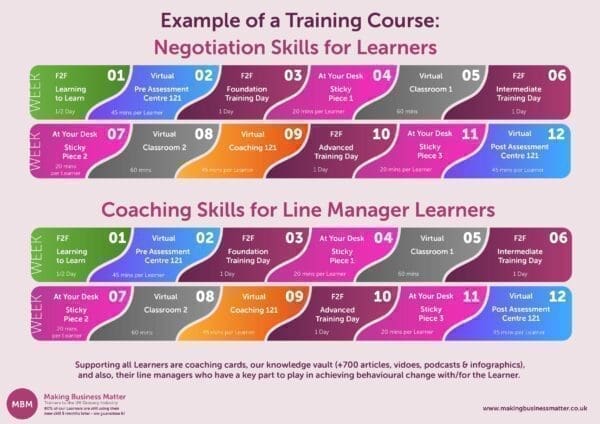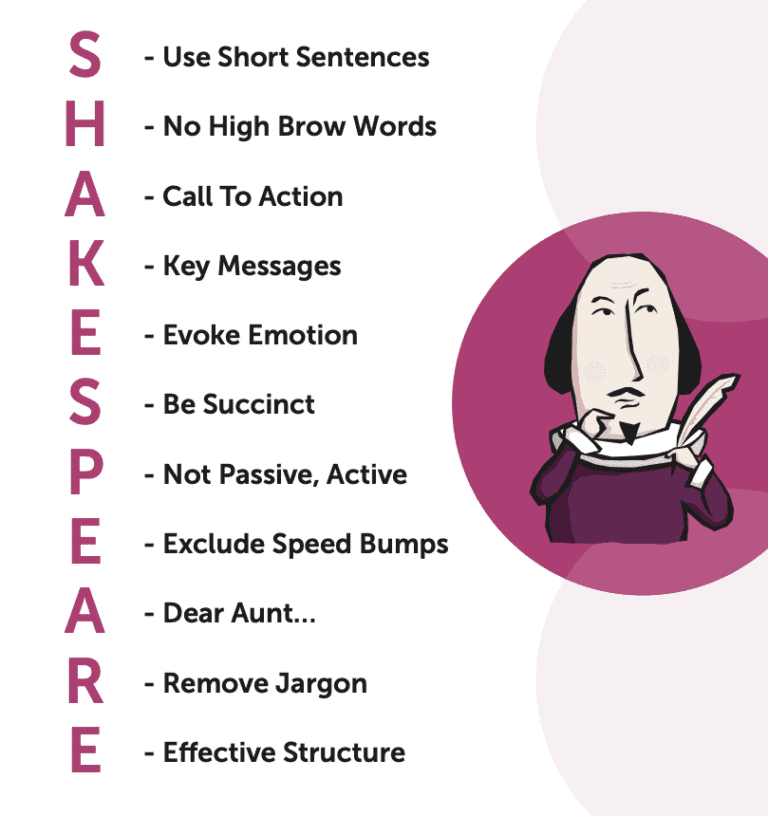The Home of Learning that Sticks. The Stickiest Learning in the World.
In this article we’ll answer the 7 most popular questions people have about Sticky Learning :
- 1 What is it?
- 2 What Problems does this Learning Solve?
- 3 How does Learning that Sticks provide a Comprehensive Evaluation/ROI?
- 4 How do you Make Learning Sticky?
- 5 What is the Theory of Learning that Sticks?
- 6 How do you Make Learning Sticky for Your Kids?
- 7 What is the Stickiest Learning in the World?
1. What is Sticky Learning?
Simply put, it is a way to achieve behavioural change. We believe behavioural change cannot be achieved through a 1-day training course and instead, we offer our clients training programmes, not training days.
Most people attend training courses and have a great day. The problem is that they do nothing differently afterwards. A person invests 8 hours of their time, a company invests money in that person, and the result is, well, nothing. No behavioural change for the learners. Learning that sticks changes that.
The analogy we use is that most training is like being asked on your driving test, ‘How many brands of car are there?’. The truth is that no one cares and what has that got to do with being able to drive? Everything we do when we train people is about achieving their behavioural change. Not transferring information that they will never use.

Our blueprint for achieving behavioural change has been developed, updated and upgraded over 20 years. We call it Sticky Learning. You might use terms like 70:20:10 or blended learning. The name isn’t important. What it achieves is – People doing things differently in the workplace as a result of our training programme, being the best version of themselves and improving their performance, which in turn improves the performance of the company.

In our minute video, you can hear about the blueprint first-hand or search for our Google reviews, like this one:

The Sticky Learning ® Blueprint
This is our blueprint below. You can click on the image to see a high-resolution pdf. The 7 key highlights of our training programme blueprint are:
- Learning to Learn: Every Learner completes LTL because it teaches them how to get the very most from their upcoming learning journey. For example, mind-mapping, why using learning quickly is important, mnemonics, why we don’t hand out slides (our Learners use Keepers ®), and how much learning a Learner loses over time.
- Pre-Assessment: To complement our Chain of Evidence (5 levels of training evaluation) we evaluate Learners in week 2 and then in week 12 to identify the behavioural changes they have made. This then gets reported in the evaluation document.
- Face-To-Face Training (F2F): These days are the backbone of the programme; Foundation, Intermediate and Advanced. Similar to face-to-face training days that you would have experienced, but much better.
- Sticky Pieces ®: These are ‘Homework’. Typically, 20 minutes of a Learner taking a learning from a face-to-face day and implementing it in the workplace. For example, if the Learner had learnt about push/pull influencing, then the Learner would use that at work to improve their influencing and record their results.
- Coaching 121: Coaching has been proven time and time again to improve the behavioural change that Learners achieve. By having their own time to discuss their learnings, results, and what it means for them, they are much more engaged in the training programme.
- Virtual Classrooms: These are similar to the face-to-face days of 1:8. One tutor to every 8 Learners. Virtual classrooms are opportunities to learn more content, share results, role-play scenarios, and ask questions.
- Coaching for Line Managers: We encourage every client to also ask their line managers to learn coaching skills so that they can support their Learners with coaching so that those Learners can become the very best version of themselves during their learning journey.
Click the image below to open a high-resolution version:

What does this Type of Learning Achieve?
Real behavioural change.
Imagine people returning to work and actually doing things differently. For example:
- They know how to prepare for a negotiation.
- Using the push/pull model to influence better.
- Not starting presentations using Powerpoint but in a much more engaging way.
- Giving regular short & quick feedback to their people.
Imagine if this were happening. People actually doing things differently as a result of being trained, because, please remember:
‘Information without application is just entertainment!’
One-day training courses are entertaining.
2. What Problems does this Learning Solve?
As well as being frustrated by people, doing nothing different when they returned from training courses, our research with HR Managers, Training Officers, and L&D Managers identified that they were frustrated with not being able to demonstrate an ROI (Return on Investment). They wanted to be able to show that their spending on external training was money well spent. Unfortunately, most training providers do not evaluate beyond the ‘happy sheet’.
3. How Does this Learning Provide a Comprehensive Evaluation/ROI?
The training industry evaluates the reaction to training. And little else. This is the part where Learners are asked at the end of the day what they thought of the day.
Kirkpatrick founded the 4 levels of evaluation in 1953; Reaction, Learning, Behaviour and Results. Yet 75 years on most training providers only do the ‘happy sheet’. Asking Learners what they think at the end of the training course.
At MBM, we use Kirkpatrick’s 4 levels to create a ‘Chain of Evidence’. This is because whilst we know that absolute numbers are hard, e.g. Training delivered an extra +1%ppt on the bottom line, and particularly for soft skills, that does not mean we should shy away from trying.
The Chain of Evidence asks Learners for their thoughts at the end of the training course, plus it also asks:
- Learning – Asks for their retention – The amount they learned through the programme.
- Behaviour – Asks what behaviours have changed – What they do differently as a result of the programme.
- Results – Asks about the impact on performance – Some specific examples of what has improved.

4. How Do You Make Learning Stick?
The unique training method is based on 6 essential elements that solve the problem for HR Managers, Training Officers, and Learning & Development Managers, of achieving no behavioural change for their Learners and not being able to demonstrate an ROI.
S is for Sticky Pieces
‘Sticky Pieces’ are activity requests, which are emailed to each Learner at the appropriate time between the Foundation and Advanced training days. They are designed to ensure habit formation is achieved so that each Learner is still using their new skills. Sticky Pieces appeal to the 70% of the 70:20:10 learning model.
T is for Timely
In essence, the ‘Spacing Effect’ states that unless we repeat, use, re-learn, or do something with what we have learnt, we’ll forget it. The Training Courses and Sticky Pieces have been designed into the learning that sticks unique training method to ensure that the Learner has the opportunity to repeat, use, or explore, their new skill in order for it to form a new habit.
I is for Individual
We created the Learning To Learn training course because many Learners have never been taught how to learn. This is a 1/2 day training course that every Learner engages with before any training. At LTL each Learner understands how they learn, how to create habits, how to identify their individual learning objectives, and how much they lose by not engaging with each activity.
C is for Curve
The ‘Forgetting Curve‘ tells us when Learners start to forget what they have remembered. By identifying these ‘windows of choice’ we can support the Learners to create long-term habits. We achieve this by helping Learners to capture their notes better, using quizzes to test them, having a learning buddy, effective line manager engagement, etc.
K is for Knowledge Vault
Learners are given access to a huge ‘Knowledge Vault’ to enable them to further continue their learning journey. The Knowledge Vault consists of well-chosen blog articles, videos, research and lots more, divided by the skill that the Learner is learning and then by the learning objective within each skill.
Y is for Your Chain of Evidence
According to CIPD 75% of training evaluation does not take place or is for level 1 only – the Happy Sheet. A ‘Chain of Evidence’ is created for each individual training programme across 5 levels of evaluation. Based on Kirkpatrick’s training evaluation model, with an additional level to review the outcomes versus the Sponsor’s business objectives.

5. What is the Theory of Learning that Sticks?
Understand why this unique training method works with these 14 compelling reasons and the science behind it:
A. One Day Training Courses have a Very Limited Effect
In the late 1800s a German Psychologist, Hermann Ebbinghaus, researched how we forget. He developed the ‘Forgetting Curve’. The important piece of his research is when we forget, e.g. After 30 days, we forget 80% of what we learnt unless the learning is repeated. We used this research to stop offering one-day courses and all our training courses are a number of separate days, with important elements in between.
Dr. Will Thalheimer also talks about how much we forget in his research paper (The first week is between 1% and 90%! Though averages at 70%).
B. Incorporating the 70:20:10 Learning Model is Essential
The 70:20:10 learning model is based on research by the Centre for Creative Leadership. The research proved that we learn best from a learning mix of 70% – On-the-job experience, 20% – Informal learning, and 10% – Formal learning incorporates this model:
- On-the-job learning – Sticky Pieces are worked on by the Learner.
- Informal learning – Each Learner is paired with a learning buddy.
- Formal learning – Training days.
The Founder of the 70:20:10 Learning Method, Charles Jennings, wrote an extensive testimonial about our free guides.
C. Line Managers are Key to the Learner Achieving their Objectives
We know that Line Managers initiate over half the conversations with their reports on the effectiveness of training. Plus, Gibb (2002) suggested that greater Line Manager involvement in learning and development promoted the notion of ‘lifelong learning’.
D. Learners Aiming to Solve a Particular Problem Achieve More
Professor Edwin Locke’s research, ‘Toward a Theory of Task Motivation and Incentives’, was pioneering because it led us to the SMART acronym that we use today. In essence, he said that we are more motivated if the task is challenging and specific. For our Learners, they learn how to identify their ‘Individual Learning Objectives’ before they begin training to live this principle.
E. The ‘Spacing Effect’ States that Higher Learning is Achieved through Repetition
Herrmann Ebbinghaus also discovered the ‘Spacing Effect‘. His research concluded that if we don’t reinforce, use, or repeat, what we have learnt, the amount we lose is exponential. The design of the learning blueprint was purpose-built to enable and encourage Learners to learn, re-learn, use, form habits, discuss, research and question at least once per month over 6 months.
F. Behavioural Change is Delivered Through New Habits
Understanding how habits are formed helps Learners to identify how they can create habits that help them to achieve change in their behaviour. Professor BJ Fogg of Stanford University is the pioneer of habit research. We share how to apply his research to our own behaviours in the 1/2 day Learning To Learn training course that takes place before any training.

G. People are More Motivated by What they Could Lose, Than What They Could Gain
‘Loss Aversion‘ was first demonstrated by Amos Tversky and Daniel Kahneman. They proved that losses are, psychologically, twice as powerful as gains. For Sticky Learning ®, this means that we share with the Learners in Learning To Learn Training Course what they will lose if they do not complete their Sticky Pieces. Plus, they are reminded of the potential % loss on each sticky piece email.
H. Mnemonics Help Learners to Learn More
Each of our trainers understands the importance of what cognitive researchers call ‘encoding’. Encoding happens when the Learner can relate a new piece of information to existing knowledge. A little like Christmas baubles. In order to add new information (baubles), you need to build it on existing knowledge/experience (Tree).
An example of a mnemonic is below – SHAKESPEARE because it will help you remember the 11 tips for writing effectively.

I. Quizzes Challenge Learners to Retain What We Have Learnt
At the end of each formal training day, the Learners are asked to complete a quiz. Whilst this is a piece of fun the science behind why is very compelling. Roddy Roediger, a Psychology Professor at Washington University, says that if we are not tested we’ll remember only 27%. Each quiz question is specific to a learning objective to test what the Learner has learnt. Groups that were tested versus those that were not were able to recall twice as much.
J. Self Discovery is a Motivating Way To Learn
Taking a new iPhone out of its box is exciting and our own curiosity drives us to learn how to make it work. Each Learner, on their learning journey through our training courses, has access to the Knowledge Vault. Built into the Knowledge Vault are cupboards for each skill and then each cupboard has a shelf relating to each of the learning objectives of that skill.
K. Knowing Your Learning Style Helps Learners to Learn More
Honey and Mumford created a questionnaire that helps Learners to identify their learning style. By identifying their learning style a Learner can learn more, learn faster and learn more easily. The phrase that helps to understand why learning styles are important is, ‘What’s the best way to ride a horse? The way it is going’.
L. Learners Learn More if they are Asked to Teach Someone Else
Our Learners are challenged to teach someone else after each learning event. This is because a study by John Nestojko, a researcher in psychology at Washington University, found that if people know that they need to teach someone else they were found to organise their recall more effectively and they had a better memory for ‘especially important information’. This would form part of what has become known as a ‘Sticky Curriculum’. This basically means that a Learner navigates the terrain of a topic that they are learning by being challenged.
The opposite end of the spectrum is to sit in a lecture theatre and be talked at for hours. A sticky curriculum is at the other end of the spectrum. For example, asking the Learner for their individual learning objective, them presenting back to their peers, or practising their new skill & seeking feedback.
M. Learners Don’t Want to Look Bad in Front of Their Peers
For each training course, each Learner is paired-up with another Learner for the learning journey. This is because each person is challenged with enabling their learning buddy to achieve their individual learning objectives. The pair organise 20-minute meetings/calls at appropriate memory drop times with the aim of being their learning conscience.
N. Learners Experience Sugar Rushes Throughout the Day
For many years, like many other training providers, we shared the hotel biscuits, offered sweets, and gorged on the afternoon tea cakes. This has now gone. Replaced with natural, no sweet, no salt, popcorn, from Scotland. Learners are able to remain focused throughout the day for longer because popcorn releases energy slowly.
6. How Do You Make Learning Sticky for Your Kids?
This is the summary of the 15 revision strategies your children can use to make their learning sticky so that they get great exam results.
Just head over to this article on revision strategies. This is how your kids can create ‘sticky knowledge’. Not to be confused with ‘Dirt time in teaching’. This stands for ‘Dedicated Improvement and Reflection Time’. In essence, DIRT is an acronym for pupils giving each other feedback on each other’s work in order to make improvements.
15 Revision Strategies from the Article Revision Strategies
-
- #1: Create a revision timetable.
- #2: Flashcards are a very effective revision strategy.
- #3: Know the exam techniques.
- #4: Study groups can work and can be a problem.
- #5: Testing is a very effective revision strategy.
- #6: Be careful of the risk of rote learning.
- #7: Testing with past papers can really work.
- #8: Highlighting text is very Useful.
- #9: Mind Maps – An effective revision technique.
- #10: Set simple smallrRewards.
- #11: Grow a Tree – A revision strategy for generation Z!
- #12: Move around. Don’t get stuck!
- #13: Coach your child.
- #14: Discipline is the key.
7. What is the Stickiest Learning in the World?
Driving lessons are, in our humble opinion, the stickiest learning in the world. This is because it works. Many people pass. It contains spaced repetition, has an inbuilt motivational individual learning objective – to learn to drive to get freedom and is practical. Not theoretical.
Here at MBM, we believe that the world of corporate training could learn a lot from humble driving lessons. We use the science that supports driving lessons to support our own version of learning that sticks. So much so, we trademarked it Sticky Learning ®.
In short, what is the stickiest learning in the world? Us.
Find out how you can justify your training spend with our 5-level training evaluation reports – Click on the image below:


